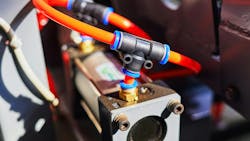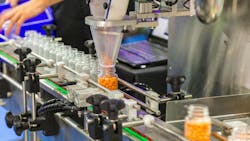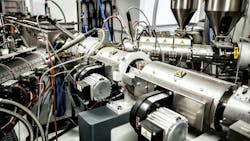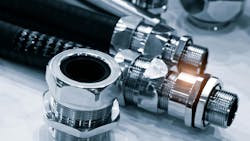NFPA 2025 Industrial Technology Roadmap Outlines Key Fluid Power Development Areas
Key Highlights
- The National Fluid Power Association’s new Technology Roadmap outlines technological needs for hydraulics and pneumatics that will be used in industrial applications.
- Machine builders are looking for cost-effective fluid power solutions which increase uptime and productivity while complying with industry regulations.
- Priority development areas fluid power companies should focus on include increasing integration of sensors as well as improving precision and control.
The National Fluid Power Association (NFPA) has announced the publishing of its latest technology roadmap, “2025 Industrial Technology Roadmap: Improving Fluid Power Components and Systems for Industrial Applications.”
The purpose of the document is to identify pre-competitive research and development needs across the fluid power supply chain. Doing so helps to inform those in the hydraulics and pneumatics industry of the technological needs in various customer markets so they can focus their design efforts on addressing them.
NFPA publishes a new technology roadmap every 2 years. For the 2025 edition, the association decided to focus on industrial applications as it felt previous versions had a heavier focus on mobile applications and it wanted to ensure it was addressing all markets fluid power serves.
Going forward, NFPA plans to issue two separate roadmaps with one focused on industrial applications and the other on mobile applications, the next edition of which is currently scheduled for publishing in 2027. NFPA stated in its press release announcing the launch of the Industrial Technology Roadmap that this dual-track approach acknowledges the distinct requirements of industrial machine builders and mobile equipment manufacturers.
Members of NFPA’s Industrial Technology Task Force — comprised of fluid power suppliers, OEMs and other stakeholders from across the fluid power value chain — helped create the roadmap document. Through industry surveys and meetings held over the course of several months, the task force determined the key research and development areas of focus to include in the 2025 roadmap.
Key Findings from the 2025 Industrial Technology Roadmap
NFPA Technology Roadmaps are comprised of five elements, each of which is connected to the next in an interdependent chain:
- Customer Drivers
- Customer Strategies
- Capability Improvements
- Research Areas
- Research Targets.
Download our eBook "Industrial Fluid Power Trends and Application Uses" to learn more about the use of hydraulics and pneumatics in industrial applications as well as the industry trends shaping their design.
The 2025 Industrial Technology Roadmap document identifies the most important priorities related to each of these elements to help the hydraulics and pneumatics sector gain better insight into what customers are looking for from their fluid power products as well as what developments may be necessary to meet these customer requirements.
Customer Drivers
NFPA defines Customer Drivers as the top-level performance objectives of fluid power customers, the OEMs or machine builders incorporating fluid power systems into the machines they manufacture. It notes these drivers help machine builders serve the needs of their own customers and are not necessarily connected to their use of fluid power.
The top Customer Drivers for machine builders in industrial applications are:
- Increased availability and up-time. Generally defined as the robustness of the machine, its ability to work continuously.
- Increased productivity and performance. Generally defined as the efficiency of the machine, its ability to do more work in less time.
- Compliance with regulations. Such as those pertaining to environmental, safety, or other concerns.
- Lower total cost of ownership. Includes capital and/or operating costs.
Customer Strategies
Per NFPA, Customer Strategies are the machine-level objectives and technologies that the machine builders have set or are using to help them achieve the top-level performance objectives described by the Customer Drivers.
A total of nine Customer Strategies were identified as top priority areas for the industrial machinery market. The NFPA Industrial Technology Task Force then conducted additional industry surveys to determine how important each of these strategies were to fluid power companies and their customers.
This enabled the task force to determine the six highest priority strategies for industrial fluid power customers:
- Safety. Improving the safe use of the machine.
- Precision Control. Improving the ability to manage systems or processes on the machine with high accuracy and minimal error, including through the use of sensors.
- Automation. Incorporating either semi- or fully-autonomous functions and/or operations on the machine.
- Maintenance and Support. Making it easier to maintain the machine, including strategies to ease initial integration and implementation, to provide documentation support, to ease the serviceability of the machine, and to increase the availability of repair or replacement parts.
- Connectivity. Expanding the use of data, such as intelligence for cloud-based condition monitoring, integration with site management systems, and/or communicating machine status for other value-added purposes.
- Electric Actuation. Moving towards electric actuation to improve efficiency or control on the machine.
Capability Improvements
Capability Improvements are defined by the NFPA as the ways in which fluid power systems must improve if they are to participate or increase their participation in the technological trends described by the Customer Strategies.
The task force identified the nine most important Capability Improvements for hydraulics and pneumatics that will help them remain the technology of choice for industrial applications:
- Data. Improve ability to monitor, gather, and use data generated from fluid power products and/or systems.
- Control. Improve the precision, performance, or ease the application of fluid power control systems.
- Energy Efficiency. Increase the energy efficiency of fluid power products and/or systems.
- Environmental Impact. Reduce the environmental impact of fluid power products and/or systems (i.e., leaks, sustainable materials, damage to environment).
- Noise. Reduce the level and harshness of the noise generated by fluid power products and/or systems.
- Power Density. Increase the power density of fluid power products and/or systems.
- Reliability and Durability. Improve the reliability and/or durability of fluid power products and/or systems.
- Safety. Improve the safe use and application of fluid power products and/or systems.
- Service. Improve the availability of replacement parts or otherwise improve the servicing of the fluid power system on the machine.
Research Areas and Targets
NFPA describes Research Areas as the broad areas of pre-competitive investigation that could assist in bringing about the Capability Improvements. Research Targets are the objectives that quantify or otherwise describe successful strategies for pursuing the Research Areas.
The association states in its roadmap document that pre-competitive research is performed when interested, but potentially competitive parties agree that there is value to be gained from a collaborative rather than a competitive approach. It is often undertaken in the early research stages when developing new technologies or determining market readiness for a new product.
Following are the key Research Areas of importance to industrial fluid power applications and the Research Targets identified as having the most impact for each:
Components. Develop new fluid power components.
- Increase integration of sensors.
- Investigate potential functions to add to hydraulic and pneumatic components.
- Improve the efficiency of individual components.
Controllability. Improve the controllability of fluid power systems.
- Simplify application of advanced control architectures.
- Increase use of wireless sensors.
- Develop accurate model-based simulations for control systems and components.
- Increase use of sensors for monitoring as well as reducing vibration and noise.
Data and Analytics. Improve the gathering and use of data analytics in fluid power systems.
- Ensure compliance with industry standard communication protocols as well as data protection regulations.
- Explore the use of artificial intelligence (AI).
- Provide system integrators with guidance on sensors.
Fluids. Optimize the use of fluids and lubrication in fluid power systems.
- Develop biodegradable fluids offering lower costs and improved performance in terms of lubricity, seal compatibility and operating temperature range.
Materials. Develop/apply new materials in fluid power components and systems.
- Investigate use of new materials such as composites and those free of PFAS (per- and polyfluoroalkyl substances).
Seal Technologies. Optimize the use of seal technologies in fluid power systems.
- Define, assess use of and educate market on best practices for seals and connection types.
- Develop seals more resistant to cutting or scratching during assembly.
Sensor Technologies. Advance sensor technologies used in fluid power systems.
- Develop sensors which can easily be applied across a system such as through miniaturization or the ability to take multiple measurements with the same sensor.
- Increase use and availability of multi-functional wireless sensors for pressure, temperature and flow measurements.
- Explore use of predictive algorithms.
System Architectures. Explore novel fluid power system architectures.
- Utilize active displacement control so only the flow required is used.
- Utilize distributed subsystems to customize pressure and flow to individual work circuits.
- Develop methods to recover and reuse energy.
About the Author
Sara Jensen
Executive Editor, Power & Motion
Sara Jensen is executive editor of Power & Motion, directing expanded coverage into the modern fluid power space, as well as mechatronic and smart technologies. She has over 15 years of publishing experience. Prior to Power & Motion she spent 11 years with a trade publication for engineers of heavy-duty equipment, the last 3 of which were as the editor and brand lead. Over the course of her time in the B2B industry, Sara has gained an extensive knowledge of various heavy-duty equipment industries — including construction, agriculture, mining and on-road trucks —along with the systems and market trends which impact them such as fluid power and electronic motion control technologies.
You can follow Sara and Power & Motion via the following social media handles:
X (formerly Twitter): @TechnlgyEditor and @PowerMotionTech
LinkedIn: @SaraJensen and @Power&Motion
Facebook: @PowerMotionTech

Leaders relevant to this article:






